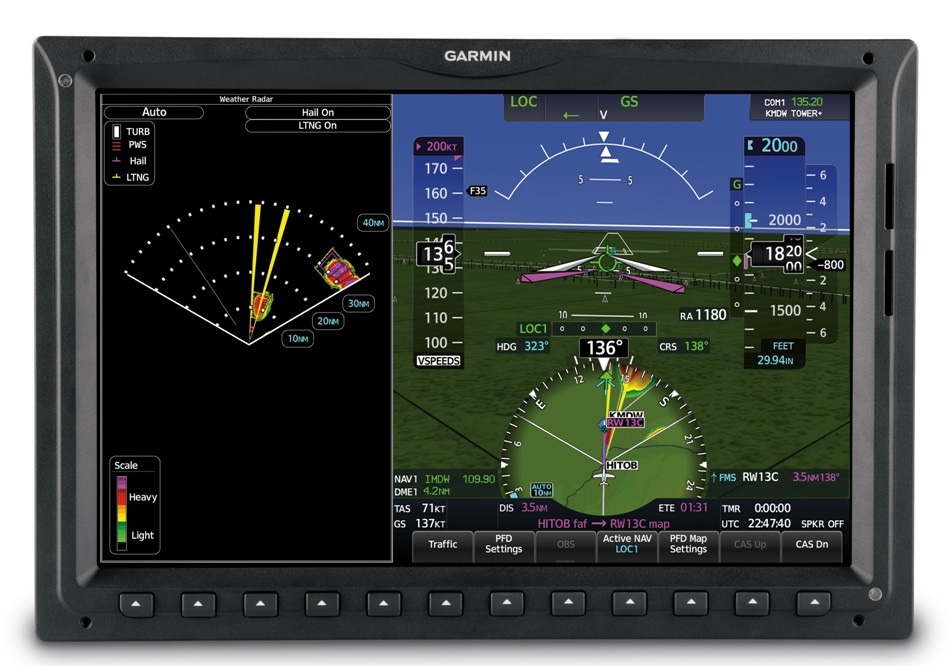Garmin International Inc., a unit of Garmin Ltd., has unveiled the GWX™ 80, an innovative weather radar that integrates automated atmospheric threat assessment capabilities to assist pilots in reducing workload in the cockpit.
The Doppler-based GWX 80, designed for commercial, business, and military aircraft, incorporates advanced ground clutter suppression, automatic 3D volumetric scanning, hail and lightning prediction, and predictive wind shear detection. A new, improved color palette also includes more color contouring compared to any other weather radar available on the market. The GWX 80 gives real-time weather information to assist pilots in analyzing convective weather threats, which helps reduce aircraft operational costs and aids in situational awareness.
 Garmin GWX 80 weather radar image on a Garmin display. (Photo: Business Wire)
Garmin GWX 80 weather radar image on a Garmin display. (Photo: Business Wire)
Compatible with select Garmin integrated flight decks, the GWX 80 has been chosen by Textron Aviation for its new super-midsize Cessna Citation Longitude along with the G5000 integrated flight deck.
With the GWX 80, we’re excited to bring a virtually zero-effort weather radar to the cockpit of thousands of new and existing aircraft on the market today. Equipped with automated 3D volumetric scanning, the GWX 80 goes beyond hail and lightning prediction to also display severe cells that may contain wind shear or turbulence. With these tools, pilots achieve greater situational awareness so they can more confidently navigate around severe weather threats and provide passengers with a better in-flight experience.
Carl Wolf, Vice President of Aviation Sales and Marketing, Garmin
Automated weather radar with 3D volumetric scanning
The GWX 80 weather radar is integrated with an advanced automation technology, which helps the pilot to more easily control the weather radar while in-flight. The GWX 80 combines 3D volumetric scanning with advanced ground clutter suppression and adjusts the tilt of the weather radar automatically in order to create the most representative depiction of flight hazards along or near the flight path of the aircraft.
Since the tilt management is fully automatic, the GWX 80 prevents pilots from under scanning or over scanning – the common errors that can happen while managing a weather radar in-flight. When pilots simply select the range of interest, the GWX 80 begins to gather multiple scans at different tilt angles to display a comprehensive and easy-to-interpret weather radar image. The GWX 80 provides a range of 320 nautical miles, pilot-adjustable sector scanning to focus on an area of interest, and horizontal scan angles of up to 120 degrees.
Predictive wind shear identification
Wind shear detection gives pilots an additional look into the storm by identifying a combination of downdrafts and updrafts and Doppler-effect that lead to wind shear formation, which is completely automated during the take-off and landing phases of flight. Pilots get aural wind shear notifications and visual indications on a Garmin display using a standard format.
Turbulence detection and hail/lightning prediction
With the GWX 80, Pilots get the opportunity to more confidently navigate around challenging weather conditions with advanced features such as Doppler-enabled turbulence detection and hail and lightning prediction, which allow for very precise weather interpretation. WATCH® (Weather Attenuated Color Highlight) helps Pilots detect shadowing effects of short-range cell activity and reveals areas where radar returns are attenuated or weakened by intense precipitation, while turbulence detection helps Pilots more easily detect turbulence in air that contains particulates or moisture.
In addition, zero blind range helps identify storm cells in close proximity to the aircraft. The GWX 80 also features unique technology that helps identify certain atmospheric conditions that may cause the formation of hail and lightning inside a storm cell. The color-coded depiction of possible areas where hail and lightning may develop or reside within a storm is depicted out to a range of 80 nautical miles, whereas turbulence is depicted out to a range of 40 nautical miles.
A high-definition color palette allows pilots to more easily read the severity of multiple storm cells or an individual storm cell in an area, which contains four times more color gradients than normally found on other weather radars available on the market.
The GWX 80 is also the lightest weather radar in its category at 13.9 lbs (6.3 kg) for the 14 inch version, providing extra savings in weight than other weather radar systems available on the market.
Garmin is looking forward to get Technical Standard Order (TSO) certification of the GWX 80 towards the end of this year.